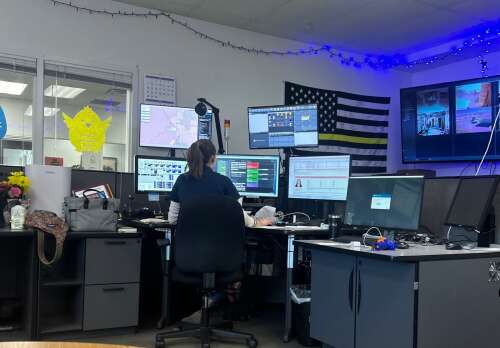National Public Safety Telecommunications week to honor dispatchers – The Journal

A Cortez dispatcher on-duty. (Kelly Codner/Courtesy photo)
The week honoring dispatchers takes place in mid-April each year
Emergency dispatchers will be recognized April 14-20 during National Public Safety Telecommunications week.
The week was launched in 1981, and was officially approved by Congress and President Bill Clinton in 1991.
Eleven full-time and one part-time dispatchers, one trainee and the dispatch supervisor work in the Cortez Police Department, but they don’t just monitor police calls.
The dispatchers also answer calls for the Montezuma County Sheriff’s Office, Mancos Marshal’s Office, Southwest Ambulance/EMS, West Fork Volunteer Fire Department, and the Cortez, Lewis-Arriola, Pleasant View, Dolores, Rico, and Mancos fire protection districts. They also work part-time and after hours at Mesa Verde National Park and Dolores County Sheriff’s Office.
Last year, Montezuma County dispatchers answered about 60,000 calls, or about 165 per day.
“We’re 24/7, 365 days a year,” a spokesperson from Cortez dispatch said. “We dispatch for all local full-time and volunteer fire, EMS and law agencies as well as MVNP and Dolores County after hours. We also answer most nonemergent calls – control burns, civil standby, fireworks, neighbor complaints, livestock, barking dogs, etc.”
Summers tend to be busier because of outdoor activities.
“Summers are busier as we have more people in the area,” he said. “People are out enjoying the outdoors, four-wheeling, hiking, hunting, boating, camping and anything else you can imagine, plus all the nefarious activities that plague our area – crime, drugs, vandalism, theft – however, winters are full of serious winter-driving accidents and highway closures.”
The spokesperson added that his favorite part of the job is helping people through a bad day.
“My favorite part is getting help to those who are having the worst day of their lives,” he said. “The largest challenge is when we don’t know where you are. We have multiple tools to help find you, but we answer the call, ‘911, where is your emergency?’ because that is the most valuable information for us getting you the help you need.”
He also has worked on suicide calls.
“I’ll always the remember the people that honored me to be the last person they spoke with. Suicide is a real problem and people are ashamed to talk about it. One conversation can save somebody’s life you care about,” he shared. “Talking about suicide will not make them do it. Don’t be afraid to have that or any other uncomfortable conversation.”
Dispatchers receive multiple weeks of industry-specific and medical classroom training, three months of on-the-job training, FEMA trainings and program-specific training that focuses on Text-to-911, Prepared911 and RapidSOS, as well as multiple federal clearances that dispatchers-in-training must acquire, according to Steven.
The spokesperson also encouraged residents to use the Text-to-911 feature.
“We’re responsible for officer, deputy, marshal, firefighter and EMS safety, as well as yours. We have an officer in the left ear and a caller in our right ear with five monitors, three mice and multiple keyboards. Please be patient with us,” he said.
According to Business Insider, dispatchers have one of the most stressful jobs in the United States. Responding to more than 240 million calls each year, they score a 98 out of 100 in stress tolerance.
Dispatchers are on duty 24 hours a day, seven days a week, often in life-or-death circumstances. Many dispatchers suffer from critical incident stress syndrome, which has similar symptoms to post-traumatic stress disorder.



